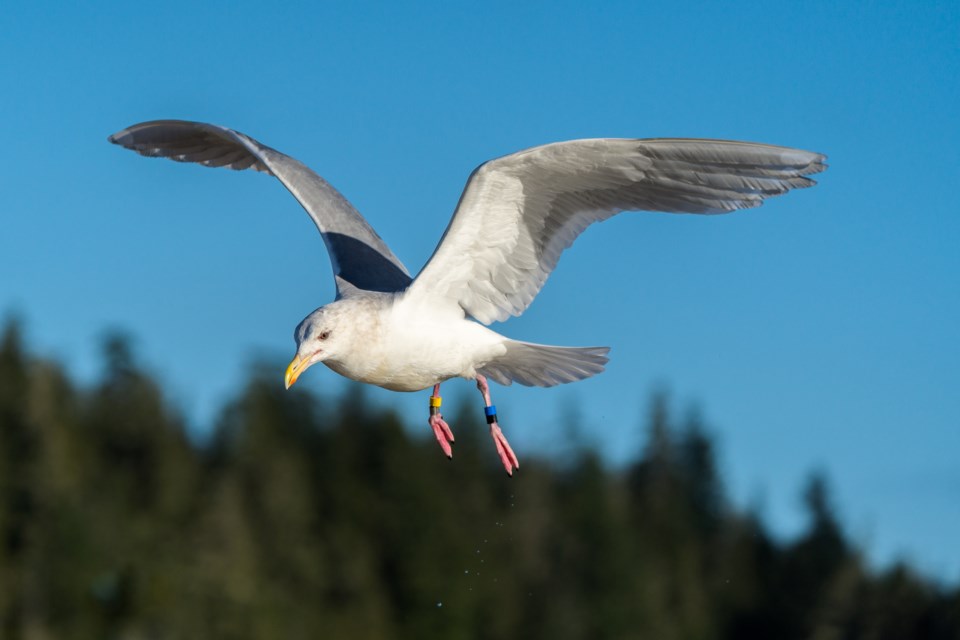If you see some people catching seagulls in Vancouver lately, they might just be federal scientists.
Mark Hipfner and his crew are researchers with Environment Canada working on a study of glaucous-winged gulls on B.C.s south coast. They're the bigger seagulls seen essentially everywhere in Vancouver.
The team is using the ubiquitous gull as an indicator of the health of the Salish Sea.
"We're taking a suite of physiological measures. So [to determine] how healthy the birds are, based on all these measurements," says Hipfner. "We also collect a sample for contaminants."
They're also banding the birds to track their ranges (more on how you can help with that below) and looking at the seagulls' genes to create a genomic map, which will tell them how different a gull from somewhere like Alaska is from one in Vancouver.
Science in the wild
The study, which is in its third year, takes Hipfner and his team, which includes fourth-year veterinary French student Neena Pradal and recent graduate Hannah Hall, to catch gulls all over the place, which includes downtown Vancouver.
Earlier in January they were underneath the SkyTrain tracks near Science World with their effective (and budget-friendly) gull-catching system: bait on a fishing line. They have or will also catch birds everywhere from Kitsilano Beach to sections of the Burrard Inlet, with other teams focusing on areas around Victoria and the North Island right now.
"Thus far the most effective bait we found are Cheezies," Hipfner says. "It's the bright colour. It kind of just sets them off in a way that nothing else we've tried does. We don't feel great about feeding them Cheezies."
"A few people have stopped and said, 'Hey, you shouldn't be—' and I'll say 'No, you're absolutely right. We shouldn't be but this is what works,'" he adds.
When the gulls go for their bright orange prize, their legs are snared in fishing line nooses.
Once they've been captured the team collects feather and blood samples, measures the bird, and bands the birds with a unique combination of leg bands, kinda like legwarmers for birds if they were made out of hard plastic.
"Each bird has a unique combination of three colour bands," he says. "Each bird that we tag is from then on individually identifiable."
Results
While the study is still early and involves teams tagging birds up and down B.C.'s coast there aren't any full conclusions yet, but Hipfner says some early results are interesting.
One piece of good news is that the local gull population is in relatively good health compared to other groups, meaning there's no undue stress on the group which might signify a broader issue.
Notably, they're also not noticing much of a physiological difference between the birds caught around the Vancouver landfill, where they eat literal garbage daily, and birds in more remote areas eating almost no human food.
So far they're all pretty much the same in any given region they've taken measurements from. However, the genomics tests aren't complete and more variation between areas might be discovered.
"I would expect to find that the birds that are feeding in the Vancouver landfill are going to be a little less healthy than the birds that are feeding on the beaches in Uclulet and Tofino," says Hipfner. "But that's not what we're finding."
He adds that since the study isn't done they may find that further analysis may change their early findings, or show new surprises.
Another discovery is the home ranges the gulls live in. They're putting GPS tags on some of the gulls, and have found a few things, like how about 40 per cent of the seagulls will dine at a garbage dump at least occasionally.
They also like water beds in a sense, as they sleep out on the ocean and then commute into the city in the morning.
"They come back early in the morning, but they tend to come back to the same locations, the same general location," says Hipfner. "They've got this little like, daily routine that they go through."
Even though they travel out into the open water to sleep, they seem to be faithful to one area on land, he adds, flying to generally the same location when they return to the city in the morning.
How to help
The teams banding and measuring the gulls are only one component of the study. They need help from the public to keep track of the seagulls once they've been released.
"If you're walking around, you might see some birds with colour bands on their legs," says Hipfner. "We're really hoping to engage like the citizen science bird group, in reporting the bands."
While there are gulls banded as part of other studies, Hipfner's team is using the trio of colours as their system.
"What we're hoping is people will just send us in observations of their banded birds when they see them," he says.
A website has been set up for people to submit their sightings. Hipfner adds that photos are appreciated in particular, so the precise banding situation can be confirmed. Reports of the wrong band order will mean the wrong bird is reported.




